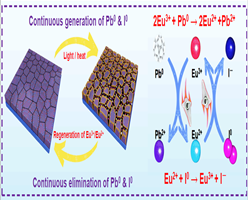Peking University, Jan. 24, 2019: Long-term stability is the most intractable issue during the commercialization of perovskite solar cells (PSCs). The intrinsic degradation of perovskite materials into Pb0 & I0 defects seriously restricts the long-term durability of PSCs. Researchers from Professor Zhou Huanping’s team in the College of Engineering, PKU and Professor Yan Chunhua’s team in the College of Chemistry & Molecular Engineering proposed a new mechanism to solve this problem.
They introduced Eu3+-Eu2+ ion pair redox shuttle into perovskite layer and achieved selectively oxidation of Pb0 and reduction of I0 defects simultaneously in a cyclical transition. The resultant PSCs achieved substantially improved efficiency and long-term durability. The related paper was published in the world's top academic journal Science on January 18, 2019, entitled “A Eu3+-Eu2+ ion redox shuttle imparts operational durability to Pb-I perovskite solar cells” (doi: 10.1126/science. aau5701).
Converting solar energy into electrical energy directly via solar cells, which is based on photovoltaic effect, is one of the most effective methods for solar energy application. Devices lifetime and power conversion efficiency (PCE) are the two key factors determining the final cost of the electricity that solar cells generate. The certified PCE of perovskite solar cells has rapidly reached 23.7% over the past few years, which surpassed the commercialized Cu(In,Ga)Se2 and polycrystalline silicon solar cells. The solution-processed feature imparts huge cost advantage to PSCs and gains tremendous attentions of worldwide researchers.
However, poor device stability under operating conditions prevents the perovskite photovoltaics from occupying even a tiny market share. The components in organic-inorganic halide perovskite materials including I–, Pb2+, MA+ and FA+ are large and with low valence ions compared with traditional inorganic photovoltaic materials such as silicon (IV group) and Cu(In,Ga)Se2 solar cells (I-III-VI group). These soft ions construct soft crystal lattice prone to deform and vulnerable to various aging stresses including electric field, thermal stress, oxygen, moisture, and ultraviolet (UV) exposure.
According to the researchers, the lifetime of PSCs can be prolonged to some extent by the maturing encapsulation methods. However, some aging stresses cannot be avoided during device operation, including light illumination, electric field, and thermal stress, upon which both I– and Pb2+ in perovskites become chemically reactive to initiate the decomposition. On the one hand, I– is easily oxidized to I0, which not only serves as carrier recombination centers but also initiates chemical chain reactions to accelerate the degradation in perovskite layers. On the other hand, Pb2+ is prone to be reduced to metallic Pb0, which has been widely observed in Pb halide perovskite films. Metallic Pb0 is an important deep-level defect that severely degrades the efficiency of perovskite optoelectronic devices including solar cell, light-emitting diodes, photodetectors. This mild but irreversible degradation, which would be accumulated day by day, might be the most intractable issue for perovskite materials and the biggest obstacle for achieving operational durability of PSCs. It is urgent and essential to solve this fundamental and intrinsic degradation.

Figure 1. Proposed mechanism diagram of cyclical elimination of Pb0 and I0 defects and regeneration of Eu3+-Eu2+ ion pair redox shuttle
To solve this intrinsic degradation issue, researchers from Zhou Huanping team, Yan Chunhua team and collaborators proposed a new mechanism and demonstrated constant elimination of Pb0 & I0 defects simultaneously in PSCs over lifetime of PSCs, which leads to exceptional stability improvement and high PCE through incorporation of the ion pair of Eu3+ (f6) ↔ Eu2+ (f7) as the redox shuttle. In this cyclic redox transition, Pb0 defects could be oxidized by Eu3+ (2Eu3+ + Pb0 → 2Eu2+ + Pb2+), while I0 defects could be reduced by Eu2+ (Eu2+ + I0 → Eu3+ + I– ) at same time. The Eu3+-Eu2+ redox shuttle is not consumed during device operation, probably because of its nonvolatility and the suitable redox potential in this cyclic transition. Thus, the champion PCE of the corresponding device was promoted to 21.52% (certified, 20.52%) with negligible current density-voltage (J-V) hysteresis. Devices with the Eu3+-Eu2+ redox shuttle exhibited excellent thermal and light stability. The devices retained 92% and 89% of the peak PCE under 1-sun continuous illumination or heating at 85°C for 1500 hours and 91% of the original stable PCE after maximum power point tracking for 500 hours, respectively. This method provides a universal solution to the inevitable degradation issue of perovskite optoelectronic devices including solar cells, LED, photo-detectors and so on. This concept can also be extended to other inorganic semiconductor materials and devices which face similar instability problems.

Figure 2: Long-term stability and original performance evolution of PSCs
The first author of this paper is Ph.D. candidate, Wang Ligang (2014), co-supervised by Yan group (College of Chemistry) and Zhou group (College of Engineering). The corresponding authors are Professor Zhou Huanping, Professor Yan Chunhua and Professor Sun Lingdong. Collaborators include researchers from Professor Huang Bolong team (Hong Kong University of Science and Technology) and the Chen Qi team (Beijing Institute of Technology). The work was jointly supported by the National Natural Science Foundation of China, the Ministry of Science and Technology, Beijing Municipal Science and Technology Project, Beijing National Laboratory for Molecular Sciences, Beijing Key Laboratory for Theory and Technology of Advanced Battery Materials.
Edited by: Huang Weijian
Source: College of Engineering

